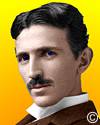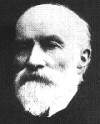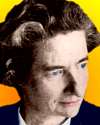On 7 Jan 1714, the world's first patent for a “Machine for Transcribing Letters” was granted in England by Queen Anne to Henry Mill (1683?-1771), a waterworks engineer with the New River Company. The record of the patent is all the information that has survived to the present, so you can read British Patent 395 of 1714 and wonder what it might have been. The web page also includes his earlier patent for “Springs for Coaches, Chariots, and Other Vehicles,” in 1706.

On 7 Jan 1943, Nikola Tesla died, the Serbian-American inventor whose contributions to alternating current distribution and machinery make him a principal architect of the modern age. Today's book pick is: Wizard: The Life and Times of Nikola Tesla : Biography of a Genius (Citadel Press Book), by Marc Seifer who describes how Tesla was far ahead of his time but also suffered from his poor financial management, while being erratic and off-beat. Many rode Tesla's coattails to public recognition and, often, staggering financial success—but Tesla was left penniless, alone, and often bypassed in the history of the great electrical pioneers. Siefer brings balance to the history and readers will learn how Tesla's inventiveness stands well against that of Thomas Edison. The author also details many of Tesla's idiosyncrasies with fascinating anecdotes.
It is available from Amazon, typically about New from $21.91. Used from $2.60. (As of earlier time of writing - subject to change.)
 | If you don’t work on important problems, it’s not likely that you'll do important work. |
 | Furious activity is no substitute for analytical thought. |
 | If he [Thomas Edison] had a needle to find in a haystack, he would not stop to reason where it was most likely to be, but would proceed at once with the feverish diligence of a bee, to examine straw after straw until he found the object of his search. … [J]ust a little theory and calculation would have saved him ninety percent of his labor. |
| Before you look at today's web page, see if you can answer some of these questions about the events that happened on this day. Some of the names are very familiar. Others will likely stump you. Tickle your curiosity with these questions, then check your answers on today's web page. | |
| Births | |
 | Sir Sandford Fleming, born 7 Jan 1827, was a Scottish surveyor and engineer who divided the world into time zones. He emigrated at age 17 years to Quebec, Canada as a surveyor. His idea of time zones, which led to the adoption of the present system of time zones earned him the title of “Father of Standard Time.” Fleming also designed the first Canadian postage stamp. Issued in 1851, it cost three pennies and depicted the beaver, now the national animal of Canada. For what business did he create the idea of time zones? |
 | Sir Lionel Alexander Bethune Pilkington was a British industrialist and inventor who invented a new manufacturing method that much improved the industrial production of a certain glass product. His innovation improved the production of which glass product? |
| Deaths | |
| no image | John Motley Morehead III (1870-1965) was an American chemist much involved in the commercial production of calcium carbide. This is an interesting chemical because both the carbon and the calcium come from inorganic rock (coal and limestone). Yet it immediately reacts with water to yield a product that is the important starting point for the syntheses of very many organic chemicals. What is the important product from the reaction of calcium carbide and water? |
 | Josef Stefan (1835-1893) was an Austrian physicist who in 1879 formulated a law that the radiant energy of a black body is proportional to the fourth power of its absolute temperature. His law was one of the first important steps toward the understanding of blackbody radiation. What is defined as a “black body” in this law? |
| Events | |
 | On 7 Jan 1785, Frenchman Jean Pierre Blanchard, with American physician and scientist John Jeffries, made the first international flight in a hot-air balloon. Across which body of water was this balloon flight made? |
 | On 7 Jan 1930, a new element was discovered by Marguerite Perey, the last naturally occurring element to be found. Mendeleev anticipated its discovery, and provisionally named it eka-cesium. Perey coine the name by which we now know it. What element was this element discovered by Marguerite Perey? |
Fast answers for the previous newsletter for January 6: a sheep, a duck and a rooster • light is emitted by the electrons • pea plants • decade including the year 1971 • Leon Foucault with a pendulum.
 If you enjoy this newsletter, the website, or wish to offer encouragement or ideas, please send feedback by using your mail reader Reply button.
If you enjoy this newsletter, the website, or wish to offer encouragement or ideas, please send feedback by using your mail reader Reply button. Your click on a Facebook, StumbleUpon, or other social button on the site webpages is also a welcome sign of appreciation. Thank you for using them.
© This newsletter is copyright 2020 by todayinsci.com. Please respect the Webmaster's wishes and do not put copies online of the Newsletter — or any Today in Science History webpage. (If you already have done so, please remove them. Thank you.) Offline use in education is encouraged such as a printout on a bulletin board, or projected for classroom viewing. Online, descriptive links to our pages are welcomed, as these will provide a reader with the most recent revisions, additions and/or corrections of a webpage. For any other copyright questions, please contact the Webmaster by using your mail reader Reply button.
--
If you do not want to receive any more newsletters, Unsubscribe
To update your preferences and to unsubscribe visit this link
Executive Real Estate Business Class
-
"It was like a man with wings. It wasn't like anything you'd see on TV or in a monster movie." ...
About the publisher
Search This Blog
Blog Archive
-
▼
2021
(585)
-
▼
January
(109)
- Ian Kershaw on why Hitler declared war on America
- On This Day for January 31 - Guy Fawkes executed i...
- Newsletter for Sunday 31 January.
- January 31: Slavery Abolished in the USA, Guy Fawk...
- On This Day for January 30 - “Great Soul” assassin...
- Newsletter for Saturday 30 January.
- January 30: Oliver Cromwell Ritually Executed, Mah...
- On This Day for January 29 - Iraq, Iran, and North...
- Newsletter for Friday 29 January.
- January 29: Romeo and Juliet, Coca-Cola and the Se...
- 'The Food That Built America' Is Back!
- On This Day for January 28 - Explosion of the spac...
- Newsletter for Thursday 28 January.
- Inside The Still-Mysterious Circumstances Of Heath...
- Demystified: What’s the Difference Between a Presi...
- On This Day for January 27 - Vietnam War ended, Wo...
- Newsletter for Wednesday 27 January.
- January 27: Kaiser Bill is Born, the Siege of Leni...
- You are now unsubscribed
- What The Wild West Actually Looked Like in 48 Reve...
- New Savings! $50 off Family Memberships
- On This Day for January 26 - First European settle...
- Newsletter for Tuesday 26 January.
- January 26: Catholic Counter-Reformation, British ...
- On This Day for January 25 - Claudius affirmed as ...
- Newsletter for Monday 25 January.
- January 25: São Paulo Founded, Charles Wilkes Disc...
- Queen Victoria and Prince Albert's marriage | Wors...
- On This Day for January 24 - Opportunity's Mars la...
- Newsletter for Sunday 24 January.
- January 24: Scouting for Boys, Apple's Macintosh a...
- On This Day for January 23 - Madeleine Albright sw...
- See All That's Interesting Most Popular Articles
- Please Confirm Subscription To Our Newsletter
- The "Alaskan Avenger" Who Attacked Sex Offenders W...
- On This Day for January 22 - Roe v. Wade ruling, L...
- Newsletter for Friday 22 January.
- On This Day for January 21 - First commercial Conc...
- Newsletter for Thursday 21 January.
- Need Context with Your News?
- Demystified: Where Do Honeybees Go in the Winter?
- On This Day for January 20 - Barack Obama sworn in...
- Newsletter for Wednesday 20 January.
- On This Day for January 19 - Rule in India transfe...
- Newsletter for Tuesday 19 January.
- On This Day for January 18 - German Empire establi...
- Newsletter for Monday 18 January.
- January 18: King of Siam Kills the Crown Prince of...
- Queen Victoria and Prince Albert: was their union ...
- On This Day for January 17 - Hawaiian monarchy ove...
- Newsletter for Sunday 17 January.
- January 17: US-Modoc War, the UN Security Council ...
- On This Day for January 16 - Beginning of Persian ...
- Newsletter for Saturday 16 January.
- January 16: Ivan the Terrible, Louis XVI's Death S...
- The Tragedy Of David Reimer, The Boy Forced To Liv...
- On This Day for January 15 - British Museum opened...
- Newsletter for Friday 15 January.
- January 15: Henry VIII and the Church of England, ...
- On This Day for January 14 - Premiere of Giacomo P...
- Newsletter for Thursday 14 January.
- January 14: The Dutch Conquer Malacca, the US Revo...
- Demystified: Why Does Water Freeze from the Top Down?
- On This Day for January 13 - Émile Zola's “J'accus...
- Newsletter for Wednesday 13 January.
- January 13: 1st Issue of "The Times" of London, Ch...
- On This Day for January 12 - Haiti severely damage...
- Newsletter for Tuesday 12 January.
- January 12: A Day of Coronation, Gandhi's Last Fas...
- On This Day for January 11 - Amelia Earhart's Hawa...
- Newsletter for Monday 11 January.
- January 11: Spices, Morse Code, Insulin and 55 Yea...
- The real history behind Bridgerton
- On This Day for January 10 - Common Sense publishe...
- Newsletter for Sunday 10 January.
- January 10: Thomas Paine Publishes Common Sense, T...
- On This Day for January 9 - Election of Mahmoud Ab...
- THE IGBO LANDING - HOW THEY COMMITTED SUICIDE
- Newsletter for Saturday 9 January.
- January 9: Joan of Arc's Trial, the Daguerreotype ...
- The Biggest Historical Discoveries From 2020 And M...
- On This Day for January 8 - Anniversary of Grimald...
- Newsletter for Friday 8 January.
- January 8: US National Debt Briefly Hits $0, Forma...
- On This Day for January 7 - Galileo's discovery of...
- Newsletter for Thursday 7 January.
- January 7: A Day of Invention - The Typewriter, Hy...
- On This Day for January 6 - Epiphany, Richard II i...
- Newsletter for Wednesday 6 January.
- January 6: Charles I put on Trial for Treason, FDR...
- Meet The Real-Life Goodfellas Whose True Stories W...
- On This Day for January 5 - Golden Gate Bridge con...
- Newsletter for Tuesday 5 January.
- January 5: Richmond Burns, The Nazi Party Forms, A...
- Last Call for 30% off Memberships
- On This Day for January 4 - Burma granted independ...
- Newsletter for Monday 4 January.
- January 4: The Colt Revolver, a 33 Year Strike and...
- Dangers of Victorian London| Roman history quiz | ...
- On This Day for January 3 - Martin Luther excommun...
-
▼
January
(109)
-
Blogroll
-
About
HistoryFact










0 comments:
Post a Comment